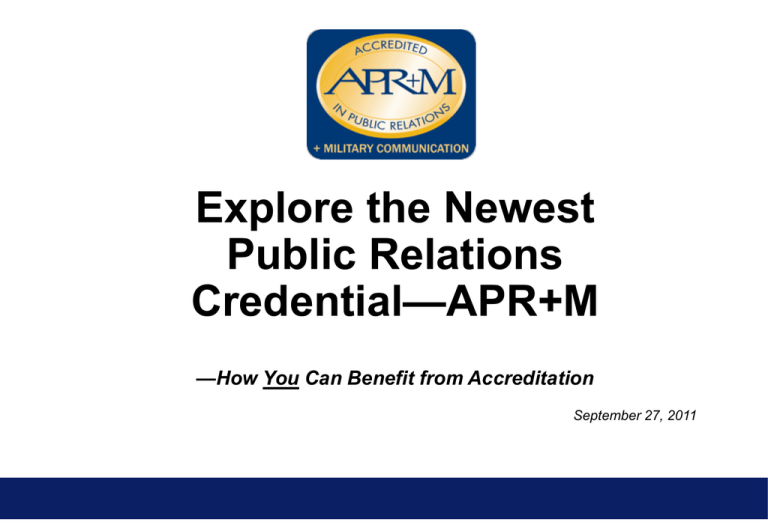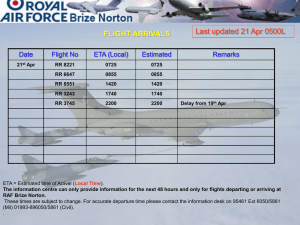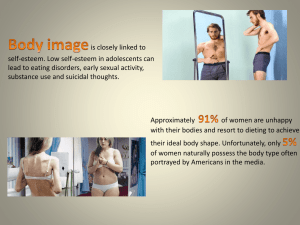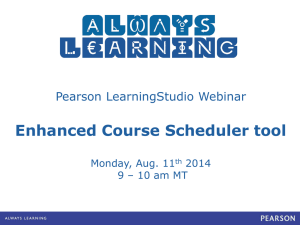Explore APR+M - Accreditation in Public Relations
advertisement

Explore the Newest Public Relations Credential—APR+M —How You Can Benefit from Accreditation September 27, 2011 Agenda APR Overview APR & APR+M Distinction Testimonial: What the APR+M Means to Me Certification (APR+M) Benefits 1 Accreditation defines, advances and unifies the profession The designation Accredited in Public Relations (APR) signifies a high professional level of experience and competence. It is a voluntary certification program for public relations professionals, administered by the Universal Accreditation Board. Sets industry standards – Public relation’s only post-graduate certification program – Measures practitioners’ knowledge, skills and abilities (KSAs) in 60 areas such as communications theory, research, planning, implementation and evaluation, crisis communications management, ethics and law – More than 5,000 professionals from the agency, corporate, association and education fields hold the APR mark, Harold Burson and Daniel J. Edelman notable among them Promotes lifelong learning – Continuing education programs required, including volunteer work or other professional development activities – Keeps skills sharp and accreditation active 2 Accreditation provides distinction and credibility to a broad profession Career enhancement – Voluntary demonstration of competency – Reflects a strong commitment to the profession – Provides a distinction that can open doors to advancement and compensation Positive for the public relations industry – PR is often misunderstood and criticized – APR gives credibility to our profession: promotes high professional and ethical standards Accredited professionals find the process establishes the practice as strategic (93%) and ethical (91%). – Accredited professionals contribute to greater understanding of public relations as a vital management function 3 Accreditation requires program standards + = UAB + DOD = APR+M 4 The purposes of APR and APR+M are distinctive: Unify and advance the Public Relations profession by identifying those who have demonstrated broad knowledge, experience and professional judgment in the field. The program seeks to improve public relations practice. The designation Accredited in Public Relations signifies a high professional level of experience and competence. Improve the profession of military public affairs and establish a standard of knowledge consistency within the joint public affairs community. It signifies a professional level of experience and competence within the Public Relations industry as a whole, coupled with a uniquely qualified understanding of public affairs activities in joint military operations. 5 The Knowledge, Skills, and Abilities (KSAs) tested for APR+M are a distinguishing factor: •Joint Planning Process •Interagency Coordination •PA Guidance (Annex F) •Crises/contingency •DOD Principles of Information •DOD FOIA •Classification and release of information •Resource, Planning, Program, Budget, Execution •PA role in Strategic Communication (Annex Y) •Operations Security •PA Role in COIN Operations 6 Elements of APR complement components of APR+M PRSA Code of Ethics + DOD Principles of Information; Nine Principles of War Coverage Crisis Communication + Contingency Planning Lobbying + 1913 Gillett Amendment Foreign Agents Registration Act + Article 5 Operations Competing Messages + Insurgent Propaganda Technology trends + Adversary Web/Social Media Freedom of the Press + Developing Media in Stability Operations 7 There are key points to remember for APR+M 1. Graduation from DINFOS is not a requirement, however… 2. You don’t have to have Joint experience, however… 3. Current military APRs are also eligible, however… 4. No professional organization membership required, however… 8 Requirements for attaining APR and APR+M: A 4-step process Step one: Eligibility and Application – A minimum of five years experience is recommended – Download application at www.praccreditation.org or www.praccreditation.org/apr_m/aprmApplication3.pdf – Single payment of $385.00 or two payments of $205.00 Step two: Written Questionnaire – Complete experienced-based questionnaire (*Note: The APR+M questionnaire is different than for the APR) to be submitted to Readiness Review panelists Step three: Readiness Review – Oral presentation of your portfolio (to include a communication plan that you developed or helped to develop) that demonstrates your mastery of KSAs – Typically three panelists – Two hours allowed including Q & A (for new candidates) – Requires panel recommendation that the candidate is “ready to take the exam” 9 Requirements for attaining APR and APR+M: A 4-step process Step four: Computer Exam (the same for both APR and APR+M) – Conducted at a Prometrics Testing Center – 3 hours, 45 minutes, including a 15 minute break – Scenario-based multiple choice questions – Specific KSAs (Knowledge, Skills and Abilities) in 10 areas of professional practice: 30% Research, planning, implementing and evaluating programs 15% Ethics and law 15% Communication models and theories 10% Business literacy 10% Management skills 10% Crisis communication management 5% Media relations 2% Using information technology efficiently 2% History of and current issues in public relations 1% Advanced communication skills – Be on time: After 30 minutes, you are considered a “no-show” 10 Testimonial: What the APR+M designation means to me Personal accomplishment – Recognition that you have reached a high level of achievement in the profession Knowledge – Going beyond your professional experience to fill-in gaps and round out your skills Leadership – With accreditation comes an expectation of ethical leadership and professionalism Professional goals – Third-party validation of your skill set has value in any industry – Consulting – Differentiates you from a competitor and shows clients you understand all aspects of the craft – Government – Illustrates to those outside public affairs office that you are a skilled professional just like a lawyer or accountant – Private Industry – Jumps off a resume and shows you are committed to the practice of public relations 11 Resources are available to help achieve APR and APR+M Resources Available – Basic Information: www.prsa.org/Learning/Accreditation/ and www.praccreditation.org/apr_m/index.html – Basic Information: www.prsa-ncc.org/accreditation_(apr)/ – Application form: www.praccreditation.org/documents/APRapplication2010.pdf and www.praccreditation.org/apr_m/aprmApplication3.pdf – Study Guide; download at: www.praccreditation.org/documents/aprstudyguide.pdf and www.praccreditation.org/apr_m/aprmStudyGuide.pdf – Recommended Readings: www.praccreditation.org/Preparation%20Sources/index.html#books • Effective Public Relations. 10th ed, Cutlip & Center • Primer of Public Relations Research. Don W. Stacks • Public Relations: Strategies and Tactics. 9th ed., Wilcox & Cameron • Strategic Planning for Public Relations. 2nd ed. Ronald D. Smith • Others – Online Course: www.online2learn.net/APR/ 12 Questions? 13 PRSA membership has a wealth of benefits Public Relations Society of America (PRSA) is the world’s largest and foremost organization of public relations professionals – 21,000+ public relations and communications professionals members from across the U.S. – Members range from recent college graduates to the leaders of the world’s largest multinational firms Networking Benefits Intelligence – 16 professional interest sections – Award-winning periodicals (Strategist, Tactics) – 110 local PRSA chapters in 10 districts – Daily News Updates (Issues & Trends, blogs) Professional Recognition – Silver Anvil Awards (national) – Thoth Awards (local) Learning – Professional development programs – Industry conferences – Access to industry intellectual capital (Silver Anvil case studies, white papers, research, articles) PRSA Job Center – Career advice library – Resume guide and critiquing service – Mentoring – Accreditation 14




